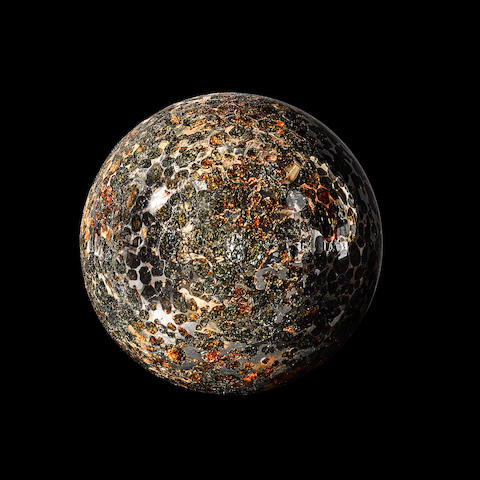Meteorites at Auction: A Category Spotlight
How much do meteorites sell for at auction? And how often are they made available?

Sericho, Kenya’s only rocks are meteorites. So many litter the ground south of town that elders reminisce about playing on mounds of them when they were children. A Sericho pallasitic meteorite (estimate: USD 18,000 – $22,000) is among the top lots in Bonhams‘ upcoming Natural History auction. The December sale is the latest example of meteorites at auction, with almost 30 different meteorites, among other lots.
Those unfamiliar with the category may consider meteorites priceless and unattainable. However, examples find their way to the auction block regularly and at a wide range of prices. In the lead-up to Bonhams’ Natural History sale, Auction Daily answers a few frequently asked questions about meteorites at auction.
How often do meteorites come to auction?
Phillips is often credited for establishing the auction market for meteorites, with a 1995 sale headlined by several notable examples. The event realized $300,000, and the following year’s sale reached $700,000. Since then, meteorites are usually featured in several auctions each year. Recently, this has been thanks to frequent natural history auctions by Bonhams and Sotheby’s, as well as annual meteorite auctions by Christie’s.

However, there is not an unlimited supply of meteorites auction houses can offer. “Although there are more than 60,000 meteorites in the world’s collections, two-thirds of these will never be available to the general public,” explains UCLA cosmochemist Dr. Alan Rubin. With a limited number of new finds, collectors are competing for a very finite resource.
One practice that helps alleviate that scarcity is the cutting of meteorites. While it may sound unorthodox, the fragmenting of these pieces is an accepted practice. “As long as there is enough material to go around, I don’t have a problem with it,” says the director of the Institute of Meteoritics at the University of New Mexico, Carl Agee. He believes that the private market for these pieces encourages others to try and find meteorites themselves. Then, each new discovery benefits scientific research.

Prior to Bonhams’ upcoming event, the most recent auction in the category was Deep Impact: Lunar and Rare Meteorites auction, presented by Christie’s in August of 2020. Top lots included a piece of Esquel pallasite and a meteorite uncovered in the Sahara desert just a year before the auction.
How much do meteorites sell for at auction?
“Collectors of every financial means can afford meteorites — it could be as cheap as $5,” says the vice president of the International Meteorite Collectors Association, Mendy Ouzillou. While auction houses like Bonhams and Christie’s are not in the business of offering lots with single-digit estimates, there is still a varied price range for high-end examples.

An Esquel pallasite is expected to cross the auction block for between $700 and $1,000 this December as part of Bonhams’ Natural History auction. The meteorite was originally discovered in rural Argentina in 1951. On the other end of the spectrum, a Muonionalusta will be offered in the same event with a $25,000 to $35,000 estimate.
Collectors could also acquire a meteorite for below the presale estimate. Christie’s Deep Impact sale this August, for example, concluded with mixed results. The event’s top lot, the previously-mentioned meteorite discovered in the Sahara, fell below its low estimate of $40,000, realizing $37,500.

How can collectors preserve their meteorites?
Meteorite storage and conservation advice is extensive. It can also vary depending on whether a collector has a stone, iron, or hybrid piece. In general, though, experts recommend avoiding moisture. “Space is dry and that is how you should keep your meteorites,” explains The Meteorite Market. If collectors would like to keep their specimens sealed, they should use a box with desiccant to prevent moisture.

Collectors should also avoid touching their meteorites with ungloved hands. Jim Tobin of Meteorite Times recommends using cotton gloves when handling specimens.
This is only a small sampling of advice from experts in the field. Buyers should do their own extensive research before starting a meteorite collection. They should pay particularly close attention to instructions regarding the kind of meteorite they want to collect.
Collectors can learn more about meteorites at auction, both past and future, in the Auction Daily archive. Bonhams’ Natural History auction will be the next sale to offer a wide selection of meteorites. Bidding begins on December 3rd, 2020, at 7:00 AM EST. Those interested can register to bid on Bonhams’ website.










